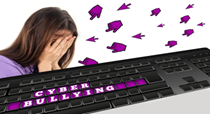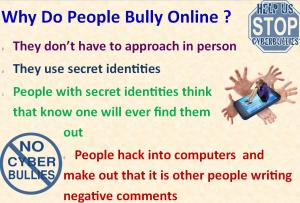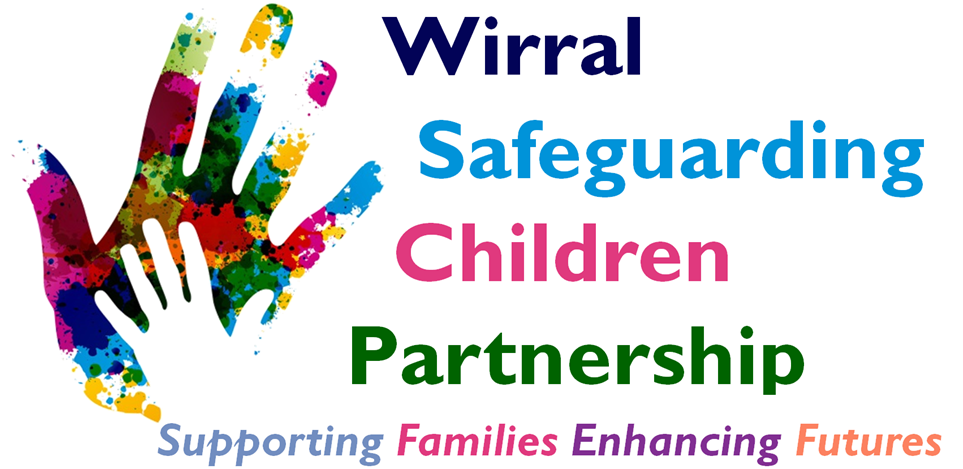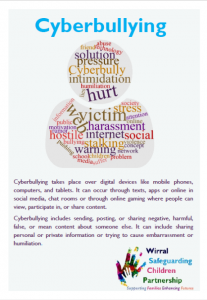Cyberbullying or Online Bullying
What does Cyberbullying mean?

Cyberbullying is bullying that takes place over digital devices like mobile phones, computers, and tablets. Cyberbullying can occur through SMS, Text, and apps, or online in social media, forums, or gaming where people can view, participate in, or share content. Cyberbullying includes sending, posting, or sharing negative, harmful, false, or mean content about someone else. It can include sharing personal or private information about someone else causing embarrassment or humiliation. Some cyberbullying crosses the line into unlawful or criminal behavior.
Internet trolling is a common form of bullying over the Internet in an online community (such as in online gaming or social media) in order to elicit a reaction, disruption, or for someone’s own personal amusement. Cyberstalking is another form of bullying or harassment that uses electronic communications to stalk a victim; this may pose a credible threat to the victim.
Not all negative interaction online or on social media can be attributed to cyberbullying. Research suggests that there are also interactions online that result in peer pressure, which can have a negative, positive, or neutral impact on those involved
How Cyberbullying can happen:
- Social Media, such as Facebook, Instagram, Snapchat, and Twitter
- SMS (Short Message Service) also known as Text Message sent through devices
- Instant Message (via devices, email provider services, apps, and social media messaging features)
- Abusing personal information
- Online gaming
- Sexting
- Online grooming
Why do people bully online?
 Sometimes people choose to embarrass, upset, pick on or intimidate other people using the internet or a mobile phone because it feels safer this way. Sending a nasty message or text can be done quickly and it means the person doing the bullying can’t see how much it hurts the other person. They might feel more distant from what they’re doing.
Sometimes people choose to embarrass, upset, pick on or intimidate other people using the internet or a mobile phone because it feels safer this way. Sending a nasty message or text can be done quickly and it means the person doing the bullying can’t see how much it hurts the other person. They might feel more distant from what they’re doing.
Effects of Cyberbullying:
Cyber bullying affects people from any age or walk of life, including children, teens and adults who all feel very distressed and alone when being bullied online. Cyber bullying can make you feel totally overwhelmed which can result in many feeling embarrassed that they are going through such a devastating time, and not knowing what support is available to them. Many children feel unable to confide in an adult because they feel ashamed and wonder whether they will be judged, told to ignore it or close their account which they might not want to do.
Signs to look out for:
- Low self-esteem
-
Withdrawal from family and spending a lot of time alone
-
Reluctance to let parents or other family members anywhere near their mobiles, laptops etc
- Finding excuses to stay away from school or work including school refusal
- Friends disappearing or being excluded from social events
- Losing weight or changing appearance to try and fit in
- Fresh marks on the skin that could indicate self-harm and dressing differently such as wearing long sleeved clothes in the summer to hide any marks
- A change in personality i.e. anger, depression, crying, withdrawn
Recent statistics show that:
- 20% of children and young people indicate fear of cyber bullies made them reluctant to go to school
- 5% reported self-harm
- 3% reported an attempt of suicide as a direct result of cyber bullying
- Young people are found to be twice as likely to be bullied on FB as any other social networking site.
- 28% of young people have reported incidents of cyber bullying on Twitter
- 26% of young people have reported incidents of cyber bullying on Ask.fm
What to do if you’re being bullied on a social network:
Most of the apps and social networking sites are for people aged 13 and over. They also state that bullying, abusive behaviours which includes harassment, impersonation and identity theft are banned and not allowed. However, results from our national bullying survey, shows 91% of people who reported cyber bullying said that no action was taken. This can leave users feeling disbelieved, vulnerable and knock their self-esteem.
A general rule when making a complaint about being bullied online is to copy the terms and conditions which have been breached and take a screenshot of the comment or photo as evidence. This may prompt any of these sites and apps to take action as you have shown them their obligation to investigate and take appropriate action.
How to report bullying or abuse on social media:
Facebook does not tolerate bullying and say they will remove bullying content when they become aware of it and may disable the account of anyone who bullies or attacks another. They have a set of community standards that they adhere to and it states that they will not tolerate:
- Pages that identify and shame private individuals,
-
Images altered to degrade private individuals,
-
Photos or videos of physical bullying posted to shame the victim,
-
Sharing personal information to blackmail or harass people and
-
Repeatedly targeting other people with unwanted friend requests or messages.
You can report bullying on Facebook using the report links which appear near the content itself, normally on a drop down arrow which gives you menu option to report the image, post or comment.
Twitter – If you receive a tweet or reply that you don’t like, you can unfollow that person. If they continue to contact you, you can block the user (just click on the head icon on their profile and select block user). You may find that as they are unable to get through to you, they will lose interest. However, if this is not the case and you continue to receive unwanted replies, abuse or threats, you can report it here straight to Twitter directly. If you know a friend or family member is being abused on Twitter, they have advice pages that can help with step by step help.
YouTube – You have every right to use YouTube without fear of being subjected to bullying or harassment. Bullying can be reported and action taken when things cross a line. To flag a video you think is inappropriate (click on the little flag bottom right of the video) and YouTube will take a look at it to see whether it breaks their terms of use. If it does then they will remove it. YouTube rules say you can’t upload videos with hate content, nudity or graphic violence and if you find one on someone else’s space, click on the video to flag it as inappropriate. If under comments, you are being bullied, harassed or threats are being made, they have a reporting tool page where you can report the bullying and they will investigate.
How to report bullying or abuse on messaging apps:
Instagram – Bullying or abuse on Instagram can happen in many ways. It can be either negative comments, fake profiles or hacking of accounts. Instagram take all of these violations very seriously and have plenty of advice on their pages if you or someone you know is being bullied or abused on Instagram. Their advice initially is to block and unfollow the person who is being abusive. However, if it continues or it has gotten worse, you can use their in-app reporting tool. This page has details on how to report the abuse directly to them.
Snapchat – Snapchat is an app that allows users to send pictures to each other that disappear off screen within a set amount of time. Unfortunately, there is bullying on Snapchat in the form of screenshots, sending pictures without permission, negative comments and more. If this is the case for you or someone you know they can block a user, tap the Menu icon, select “My Friends,” locate their name in the list and swipe right across their name. If you would like to delete a friend from your contacts, press “Delete.” Even if you haven’t added the user as a friend, their name will still appear in the “My Friends” list under “Recent” if they have sent you a message recently. If you receive an inappropriate photo or someone’s harassing or bullying you, report it by filling out their online form.
WhatsApp –WhatsApp Messenger lets people sends instant messages, videos, photos, and short audio messages to either one person or within a group chat. Messages can only be sent to other smartphone users who also have WhatsApp. Once you install the app, it checks your address book to see if anyone else you know is already using WhatsApp, and connects you automatically. You have to be over 16 to use WhatsApp legally. Bullying can take many forms as it is a messaging service and we often hear of abusive group chats. You can block and delete the contact. You can find out more by emailing them at [email protected].
General safety tips:
Keep it private – Don’t post anything on a social networking site which gives your real name, address, school, phone number or which will allow a stranger to contact you in real life. Make sure you don’t ID your friends either.
Don’t upload anything that might embarrass you at a later date. You might not realise it but things you post on the internet now could come back to cause problems for you later on, for instance when you go for an interview for college or a job. So if you are not happy for it to be shown to the world then do not hit send. Remember once you send it you have lost control of that image or comment.
If you have a webcam or smartphone never be pressured into taking pictures of yourself that you wouldn’t want other people to see. Trust your gut instinct over this. Once again, once you hit send, you have lost control over that picture and this can cause anxiety and stress.
If you’re using a shared computer at school, in an internet cafe or library then you’ll stay logged on even when you close the browser. So don’t forget to log off when you’ve finished the session. Read more tips about staying safe online.
Protecting your tweets – on Twitter you can choose to protect your tweets so that people can only follow you if you approve them first. You can select this by going into the ‘settings menu’ then ‘security and privacy’ and ticking the box for ‘protect my tweets’. Find out more about the difference on Twitter between public and protected tweets.
Location settings –Many social networks like Facebook and Twitter allow you to post your location or check in each time you tweet or post a status update. This might seem like fun for your friends to know where you are, but it can also mean that people you don’t know will see where you are, especially if you’re tweeting from your mobile on a profile that is public. To turn off the location settings, go into the ‘Settings’ menu, scroll down ‘Security and privacy’ then to ‘Tweet location’ and untick the checkbox that says ‘Add a location to my tweets’. You can also press the button that says ‘Delete all location data’, to clear information about where you’ve been in the past.
Snapchat has developed a new feature called Snap Map which can show your location. It is very important to turn this feature off so you are able to keep safe. Snap Map tracks your current location and places your avatar on a map like a pin. This can allow others to zoom in and find exactly where you are. It doesn’t take effect until you update the app, and it has an opt-out option. If you’re opening the app for the first time after the update, Snapchat will walk you through a step-by-step tutorial on how to use the Snap Map. First, it’ll show you how to pinch and zoom in the camera tool to access the map. Then, it’ll ask who you want to see your location. You get three choices: all your friends, select friends, or only me. Choosing ‘only me’ activates what it calls ‘ghost mode’ meaning you can see others but they can’t see you. To turn off location data altogether, you’ll need to visit your phone’s settings where you can scroll down to Snapchat, click on ‘location’, and choose to never share.
Hashtags – Be wary of using hashtags as that can open up your post to be visible on that particular hashtag thread on any social network or app. It can open up your post and your account to a wider audience than you originally intended.
Inappropriate behavior – If anyone makes you feel uncomfortable or embarrassed online then please tell your parents or someone that can help. If they’re doing it to you then they might also be doing it to other people. It’s particularly important never to meet up with anyone you meet online in real life, if anyone suggests that to you and particularly if they suggest you keep it secret that’s a real danger sign. Read more about recognising dangerous websites.
When you go into a social networking site people might approach you to be a friend but remember that no matter how much they tell you about themselves, they are still strangers and they might not be telling you the truth about themselves. There have been cases of adults pretending to be young people to chat to them online and try and involve you in inappropriate activities. This is called grooming and is a criminal offence. CEOP (The Child Exploitation and Online Protection Centre) investigates cases of sex abuse and grooming on the internet. Incidents can be reported by clicking the red button on the top right hand corner of the CEOP website.
Although the police can get information from your computer’s hard drive, it’s helpful if you don’t delete anything you think is dodgy until the police have decided whether they need it as evidence.
Removing or blocking friends
Facebook – click on their profile, then on the ‘message’ button dropdown and you will see the option to ‘unfriend’. You can also block a person this way.
Twitter – to remove or block someone on Twitter, click on the button with a head icon on it next to the ‘Follow’ button on a user’s profile. If you click on this you will see a menu with the options to BLOCK the user to prevent them from seeing your profile, and vice versa, and you can also REPORT FOR SPAM, which will alert Twitter to any users who are abusing the service. Read our article about Twitter safety.
YouTube – go to your account page and click on “All Contacts” link in the “Friends and Contacts” section. Choose which person you want to unfriend and the click on “Remove Contacts”. From then on the person won’t be on your “Share Video” list.
WhatsApp – You can click on the name and then you will be taken to a dropdown menu and you can then choose to block the person.
Snapchat – to block a user who added you follow the steps below. Tap ‘Added Me’ on the Profile Screen. Then tap their name, and tap the wheel icon next to their name. Press ‘Block’ to prevent them from sending you Snaps, Chats, or from viewing your Stories.
Instagram – when you block someone, they can’t see your profile or posts. People aren’t notified when you block them. To block or unblock someone, tap their username to open their profile and then tap the three dots and press the option to block user.
Closing your account
Facebook – to deactivate your Facebook account go to the “settings” tab on the Account page. That will remove your profile and content and nobody will be able to see your details or search for you. But if you decide to reinstate the account later then the whole lot will be restored, including your friends and photos. If you would like to permanently delete your Facebook account, log in to your account, click ‘Privacy and Settings’, ‘See More Settings’ and select ‘Delete my account’. Once you have confirmed your wish to delete your Facebook account it can take up to fourteen days for it to happen.
Twitter – on the settings tab on your profile, you will see ‘deactivate my account’ at the bottom. Click on this to delete your account. You have 30 days to change your mind otherwise your profile, all of your tweets and data will be permanently deleted.
YouTube – click on “My Account” in the top right hand corner and under “Account Settings” click on “Delete Account”. Give the reason you’re quitting the site and your password and then click “Delete My Account”. Log out by clicking the link in the top right hand corner. Your videos will be removed from the site immediately and the thumbnails will disappear as soon as YouTube is updated. Your profile is removed permanently.
WhatsApp – you can remove the app from your smartphone either through app management in settings or by going into the settings of WhatsApp.
Snapchat – Open the Snapchat app, login and tap the Settings icon in the upper right corner. Navigate to Support and then Learning the Basics and then click on delete an account.
Instagram – Log into Instagram from a mobile browser or computer. You can’t temporarily disable your account from within the Instagram app. Click your username in the top right and then select Edit Profile. Click temporarily disable my account in the bottom right and follow the on-screen instructions. If you want to delete your account permanently, go to the Delete Your Account page. If you’re not logged into Instagram on the web, you’ll be asked to log in first. Select an option from the drop-down menu next to Why are you deleting your account? And re-enter your password. The option to permanently delete your account will only appear after you’ve selected a reason from the menu. Click or tap permanently delete my account.
Don’t get into an argument or post offensive material
Don’t get into arguments online, this is called flaming and it can get nasty. If you break the rules of whichever site you’re on then the content is likely to be removed and you might have your membership terminated. You’re not allowed to upload anything which is offensive or racist and which promotes physical harm so don’t make threats to anyone. Neither are you allowed to harass people or to encourage other people to harass them. You’re not supposed to ask for personal information from anyone under 18 either so if you are under 18 and anyone asks you, for instance, where you go to school, make sure you report them.
Spreading rumours
Don’t spread rumours or make up false things about a friend you have fallen out with. You are not allowed to upload anything which is threatening, abusive or which is defamatory. It’s defamatory if you say untrue things about someone which give them a bad reputation they don’t deserve. It can also be harassment which is a criminal offence in the UK.
You’re not supposed to upload a picture or video of anyone without their permission either. So never set up a social networking website account in the names of other people or upload false information about them.
Support Links:
Childline for more information click here
NSPCC for more information click here
Bullying uk for more information here
Kidscape for more information click here
Children’s Stories of how Cyberbulling affected them:
Click into the Leaflet to download

